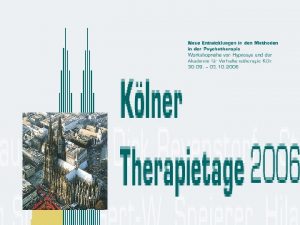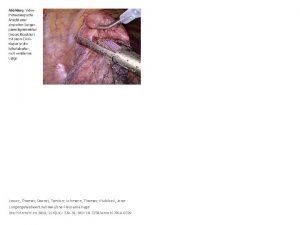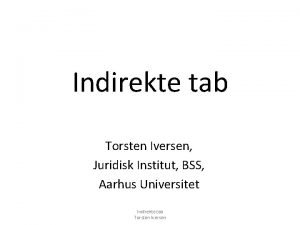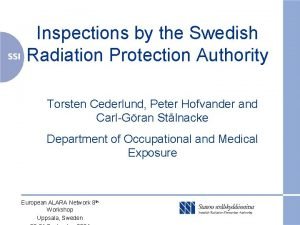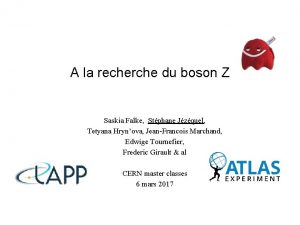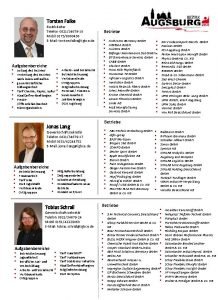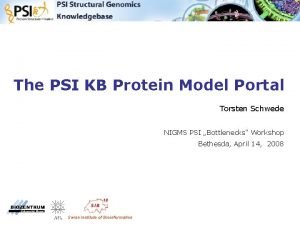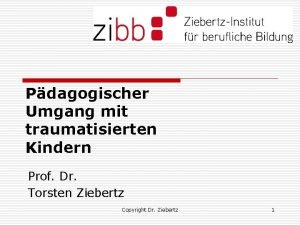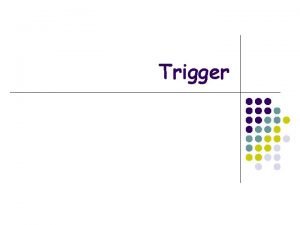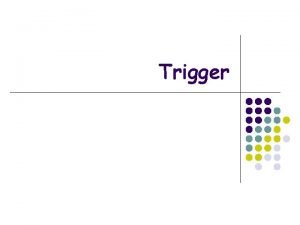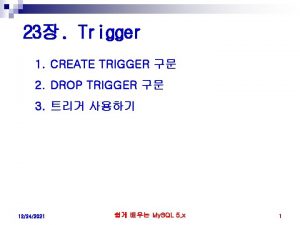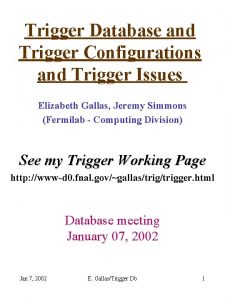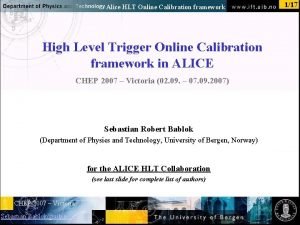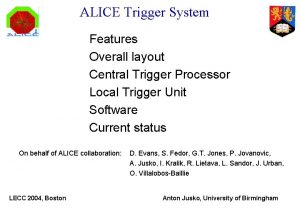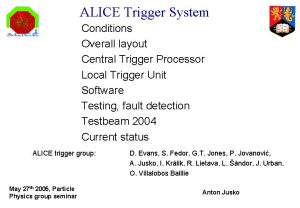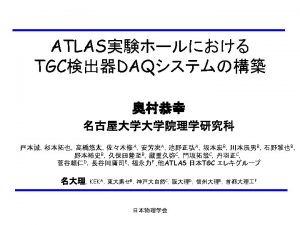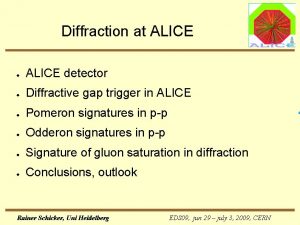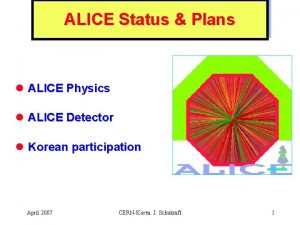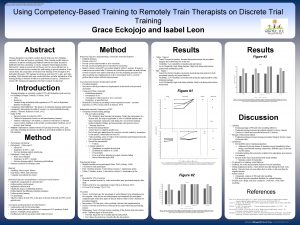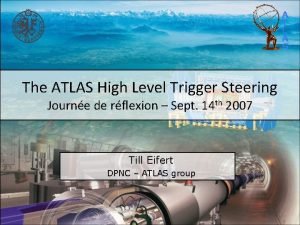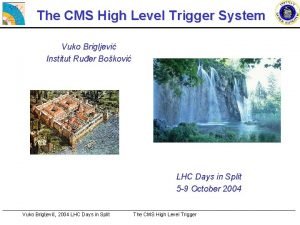ALICE High Level Trigger The ALICE HighLevelTrigger Torsten


























- Slides: 26

ALICE High Level Trigger The ALICE High-Level-Trigger Torsten Alt - KIP Heidelberg IRTG 28/02/2007 1

Overview The ALICE High-Level-Trigger: • dataflow in the ALICE experiment • trigger systems : L 0, L 1, L 2 • TPC – largest datasource • High-Level-Trigger: Tasks & Implementation The HLT Read. Out-Receiver-Card (H-RORC): • Tasks & Requirements • Implementation Torsten Alt - KIP Heidelberg IRTG 28/02/2007 2

The ALICE detector ITS : Inner Tracking System TPC : Time Projection Chamber TRD : Transition Radiation Detector Torsten Alt - KIP Heidelberg IRTG 28/02/2007 3

Trigger • L 0 - 1. 2µs : event occured • L 1 – 6. 5µs : start sampling in the Front-End-Electronics • L 2 – 88µs : readout data from the Front-End-Electronics data buffer L 0, L 1, L 2 look for „valid“ events and trigger the readout! Torsten Alt - KIP Heidelberg IRTG 28/02/2007 4

High-Level-Trigger : HLT Needs for a High-Level-Trigger: • the sub-detectors produce more data than a permanent tape storage system can handle • Online analysis allows to trigger for rare events i. e. jets • Events can be „tagged“ to prepare them for later offline analysis Torsten Alt - KIP Heidelberg IRTG 28/02/2007 5

HLT - Dataflow TPC TRD ITS Di. Muon HLT Permanent Storage Torsten Alt - KIP Heidelberg IRTG 28/02/2007 6

HLT - Dataflow TPC TRD ITS Di. Muon IN: 16 GB/s HLT OUT: < 1, 2 GB/s Permanent Storage Torsten Alt - KIP Heidelberg IRTG 28/02/2007 7

Picture of the ALICE TPC Sector P. Glaessel – will be replaced by ITS later Torsten Alt - KIP Heidelberg IRTG 28/02/2007 8

Event in the STAR TPC Torsten Alt - KIP Heidelberg IRTG 28/02/2007 9

TPC Read-Out Electronics pad OROC row • • • IROC 2 x 18 sectors ( Side A & C) 6 readout partitions (patch) per sector : 216 patches ~ 26 rows per patch ~ 90 pads per row = 557, 568 pads Torsten Alt - KIP Heidelberg IRTG 28/02/2007 10

HLT Infrastructure for one TPC sector Front-End Processors FEP BDW H-RORC RP CF HLT - cluster reconstrcution data flow display data flow BDW FEP BDW H-RORC RP CF TR H-RORC RP CF TDS BDW HLT FEP BDW H-RORC RP CF Online Display BDW DAQ second sector Torsten Alt - KIP Heidelberg IRTG 28/02/2007 11

Tracking in the HLT Raw Data(Ordering, Zero Suppression) - Data amount + Computing amount Cluster Finding (in readout partition) Can be done in the FPGA Tracking (Conformal-Mapping / Track Follower) Torsten Alt - KIP Heidelberg IRTG 28/02/2007 12

Clusterfinding 1 Torsten Alt - KIP Heidelberg IRTG 28/02/2007 13

Clusterfinding 2 Torsten Alt - KIP Heidelberg IRTG 28/02/2007 14

HLT in the pit – Counting Room 2 &3 CR 2 & 3 : HLT Beampipe ALICE Torsten Alt - KIP Heidelberg IRTG 28/02/2007 15

The HLT Cluster First Stage : • Installation will take place from 28. 2 to 7. 3. • 80 server with 2 x Dual. Core Opteron • Each server will be equipped with 2 RORCs • Each server will be equipped with a remote control system : CHARM • 216 incoming DDLs for the TPC • 10 outgoing DDLs to the DAQ HLT Prototype at KIP Torsten Alt - KIP Heidelberg IRTG 28/02/2007 16

The H-RORC Torsten Alt - KIP Heidelberg IRTG 28/02/2007 17

H-RORC Block diagramm DDR-SD USERFLASH DDR-SD CFGFLASH XC 95144 CPLD OSC CMC-J 11/J 22 CMC-Connector Configuration CMC-Connector Memory Serial links RS-232 ETH-PHY TAGNET PLATFORM PROM Power 1 V 2 Power 1 V 8 OSC PCI-66/64 Power 2 V 5 POWER LVDS links XILINX VIRTEX 4 LX 40 PCI-Power 3 V 3 Torsten Alt - KIP Heidelberg IRTG 28/02/2007 18

H-RORC Overview • H-RORC : HLT Read-Out Receiver Card • Tasks: – Receiving of the raw detector data – Injecting the data into the main memory of the hosts of the HLT framework – Online processing of the data in hardware – Sending processed data out of the HLT – Serve as a developing platform for new designs • Requirements : - Flexible and modulare architecure - Possibility to upgrade to larger FPGAs - Safe update of the firmware Torsten Alt - KIP Heidelberg IRTG 28/02/2007 19

Clusterfinding in the FPGA 1 • • • Each datapoint is represented by 4 -dimensional vector (row, pad, time, charge) Processing can by done for each row independently: Clusterfinding is a parallel process Clusterfinder operates on (pad, time, charge) Main operations: add, multiply, compare, store Main operations can be done in parallel Torsten Alt - KIP Heidelberg IRTG 28/02/2007 20

Time Clusterfinding in the FPGA 2 Pad Add & Multiply RAW Compare & Add Decoder Store Merger • 1. stage: CF-DECODER CF calculate the weighted time, the sequential charge and the total charge. • 2. stage: CF-MERGER The values are compared and merged if they correspond • 3. stage: DATA-MERGER The clusters are written to a memory Data-Merger Clusterfinder Torsten Alt - KIP Heidelberg IRTG 28/02/2007 21

Secure Configuration DDR-SD USERFLASH DDR-SD CFGFLASH XC 95144 CPLD OSC CMC-J 11/J 22 CMC-Connector Configuration CMC-Connector Memory Serial links RS-232 ETH-PHY TAGNET PLATFORM PROM Power 1 V 2 Power 1 V 8 OSC PCI-66/64 Power 2 V 5 POWER LVDS links XILINX VIRTEX 4 LX 40 PCI-Power 3 V 3 Torsten Alt - KIP Heidelberg IRTG 28/02/2007 22

Secure Configuration 2 FLASH CPLD USER 2 Virtex 4 FPGA USER 1 Write Secure. Conf PCI A user configuration can be written to the FLASH via PCI. Depending on the size of the FLASH several user configurations can be stored. Torsten Alt - KIP Heidelberg IRTG 28/02/2007 23

Secure Configuration 3 FLASH CTRL CPLD CTRL/STATUS USER 2 Virtex 4 FPGA USER 1 Configuration data Secure. Conf PCI The CPLD checks the FLASH for a valid user configuration and the FPGA is then configured with this configuration Torsten Alt - KIP Heidelberg IRTG 28/02/2007 24

Secure Configuration 4 FLASH CPLD WATCHDOG USER 2 Virtex 4 FPGA USER 1 Secure. Conf PCI After configuration a watchdog is enabled inside the CPLD. It needs to be disabled by a defined sequence send via PCI. If anything goes wrong and the watchdog isn`t disabled, it will time out and the FPGA will be reconfigured with the Secure. Conf. Torsten Alt - KIP Heidelberg IRTG 28/02/2007 25

Secure Configuration 5 FLASH CTRL CPLD CTRL/STATUS WATCHDOG USER 2 Virtex 4 FPGA USER 1 Secure. Configuration data PCI The watchdog has timed out and the FPGA is reconfigured with the Secure. Conf. The Secure. Conf contains a design which will always give access to the FLASH via PCI. Torsten Alt - KIP Heidelberg IRTG 28/02/2007 26
 Torsten grüttert
Torsten grüttert Torsten reil
Torsten reil Tim kohlmann
Tim kohlmann Torsten doenst
Torsten doenst Torsten iversen
Torsten iversen Torsten alt
Torsten alt Torsten cederlund
Torsten cederlund Torsten zesch
Torsten zesch Torsten falke
Torsten falke Torsten falke
Torsten falke Torsten reil
Torsten reil Pädagogischer umgang mit traumatisierten kindern
Pädagogischer umgang mit traumatisierten kindern Torsten kranz
Torsten kranz Low-level thinking in high-level shading languages
Low-level thinking in high-level shading languages Hát kết hợp bộ gõ cơ thể
Hát kết hợp bộ gõ cơ thể Lp html
Lp html Bổ thể
Bổ thể Tỉ lệ cơ thể trẻ em
Tỉ lệ cơ thể trẻ em Gấu đi như thế nào
Gấu đi như thế nào Chụp phim tư thế worms-breton
Chụp phim tư thế worms-breton Bài hát chúa yêu trần thế alleluia
Bài hát chúa yêu trần thế alleluia Các môn thể thao bắt đầu bằng tiếng chạy
Các môn thể thao bắt đầu bằng tiếng chạy Thế nào là hệ số cao nhất
Thế nào là hệ số cao nhất Các châu lục và đại dương trên thế giới
Các châu lục và đại dương trên thế giới Công thức tiính động năng
Công thức tiính động năng Trời xanh đây là của chúng ta thể thơ
Trời xanh đây là của chúng ta thể thơ Cách giải mật thư tọa độ
Cách giải mật thư tọa độ
